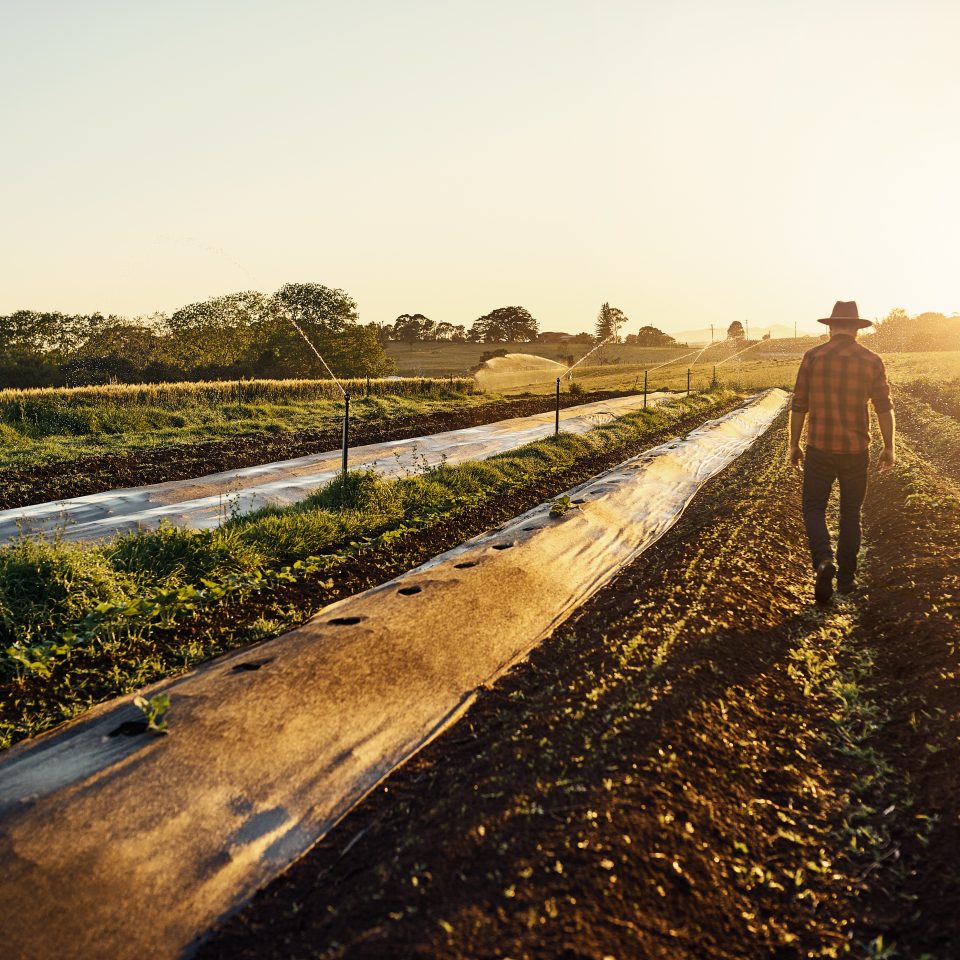
A Key Ingredient to Quality Crops
Potassium (K) levels have been declining in Ontario fields for several years now. Many fields that have been sampled have noticed a drop in their soil sample potassium levels from previous testing. Generally speaking, growers are not applying enough fertilizer.
In some cases fertilization is less than what the crop will remove causing a decrease in soil nutrient reserves. Potassium is one of the three macronutrients needed in large quantities by plants. This essential nutrient could be a limiting factor in your crop yields if your soil is not maintained at adequate levels.
The Importance of Potassium to Your Crop:
Looking for ways to increase your crop yield and quality? You can often look no further than Potassium. It is one of the nutrients that is critical to your crops success.
Here is why:
Enzyme Activation: Enzymes are important in the plant for chemical reactions to occur. Potassium ‘’activates” at least 60 different enzymes which aid in plant growth.
Water Use: Potassium regulates and monitors the opening and closing of stomates (which are the pores in leaves that exchange water vapour, oxygen, and carbon dioxide with the outside atmosphere). Guard cells surround the stomates. On a dry year when the water is scarce, potassium leaves the guard cells causing the pores to close and retain the water minimizing drought stress for the plant. If your soil levels are low, the pores often become slower to respond, allowing more water to escape. Having higher potassium level near the roots of plants increases water uptake as well.
Photosynthesis and Sugars: When plants are deficient in potassium, both the rate of photosynthesis and the movement of sugars is decreased. It also aids in uniformity of ripening as well as growth rate.
Water and Nutrient Transport: Adequate K levels in your soils and in your plant will keep the nitrates, phosphates, calcium, magnesium, amino acids, and water moving consistently through the xylem.
Protein Synthesis: Producing protein and enzymes in the plant that regulate growth processes wouldn’t be possible without adequate potassium.
Crop Quality: A sufficient K level reduces lodging, improves quality, enhances disease prevention and helps increase resistance to pests and environmental stresses.
Potassium in Soils:
There are 3 forms of Potassium that exist in fields:
- Unavailable: Depending on soil type, in general 90-98% of total soil potassium is found in this form. Typically it is in a crystalline – insoluble form. Eventually minerals break down from weathering and release potassium. But this process takes very long so not enough potassium will be made available to the plant though this process through the growing season.
- Slowly Available: Typically this form is trapped between layers of clay particles. The shrinking and swelling of these clays will release nutrients during the growing season.
- Readily Available: Potassium dissolved in soil water and held on exchange sites on clay particles is considered readily available.
Potassium availability in soils and plant uptake is determined by many factors such as: Soil Aeration, Soil Test Levels, Cation exchange capacity, Temperature, and Moisture.
Critical Soil Test Levels
In Ontario the critical level for potassium is, on average, 120 ppm on depending on soil type. Below these levels crop yields can be severely limited. It is important to note that different crops have different critical test levels, and your experts at Sylvite can help you identify what level of K is sufficient in your soils for your crops.
Large Potassium Removers:
Soybeans, Silage Corn, Alfalfa, Tomatoes, Tobacco, Small Grains (straw removed)
| Average Crop Potassium Removal | |
| CROP | K20 (lbs Removal per Unit) |
| Grain Corn | 0.28 per Bushel |
| Silage Corn | 23.13 per Ton |
| Soybeans | 1.40 per Bushel |
| Alfalfa | 60 per Ton |
| Wheat (straw removed) | 1.34 per Bushel |
| Tomatoes | 7.13 per Ton |
| Tobacco | 110 per Ton |
Potassium Sources:
There are many different sources available. The one used will mainly depend on your budget and how quickly it needs to be available.
- Muriate of Potash (0-0-60, 0-0-62) either Red or White – takes time to breakdown until it is plant available
- Sulphate of Potash Magnesia (0-0-22-12Mg-20S) – will breakdown quickly and readily available
- Potassium Sulphate (SOP) (0-0-50-18S) – readily available
- KaLime (0-0-5-29Ca-1Mg-3S) – readily available potassium, also contains a liming agent as well as micronutrients for a balanced soil amendment
- Liquid starter fertilizers such as Alpine G241-S – readily available
- Several different foliar K products – readily available
Potassium Deficiencies in Crops:
Potassium is highly mobile in a plant and therefore can be translocated into new tissue rapidly. This causes deficiency symptoms to show up on the older leaves first. Often leaf margins will be affected. You will notice a yellow to brown (scorched) colouring that borders the leaf typically at the tip. Often the middle will stay green for some time until the leaf dies. As the deficiency worsens, the symptoms will move up the plant. In corn, most deficiencies will appear when the corn is between 15 inches tall through tasseling.
Below is pictures of Potassium Deficiency in Corn, Soybeans, Wheat, and Tomatoes.
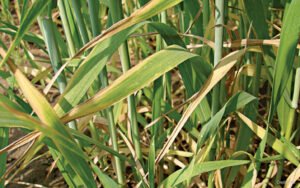
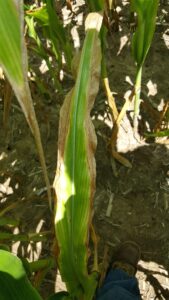
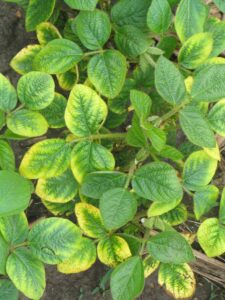
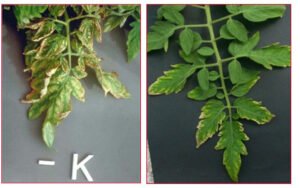
How to Correct Deficiencies?
First you have to know to start. The best way to understand this is by soil testing your soil. This is the best investment you can make into your field, to understand what nutrients you need and where you need them.
Secondly, the best way to avoid deficiencies is through routine potassium application, often in the form of Muriate of Potash in the fall. It’s economical and fall generally provides the time to perform these applications. In a very low soil test K situation, including a readily available form in the starter can also help. Once the crop is established your options are more limited. Foliar fertilizers containing larger amounts of potassium and liquid products that can be side dressed must be used. These sources can only provide a relatively small portion of what is needed for the current crop. The soil levels will still have to be addressed for future seasons.
Late Season Symptoms in Corn:
- Shorter ear length
- Lighter grain
- Incomplete grain filling
- Thinner and weaker stalks
- Increased stalk rot in your field
Sources: http://www.ipni.net/, http://www.extension.umn.edu, http://extension.agron.iastate.edu, http://www.alcanada.com, http://www.extension.iastate.edu, http://smallfarms.oregonstate.edu, www.mhhe.com